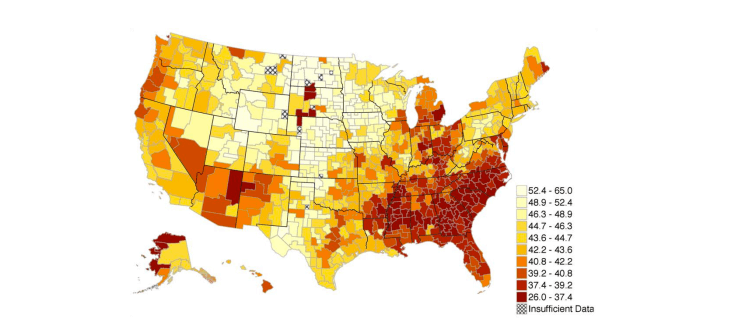New York Is One of the Best Places to Live the American Dream, But Will That Last?

A map of where the rich get rich and the poor stay poor. That’s how it goes. Everybody knows.
There was a time when the American Dream was still thought of as a real thing, a time when the potential for class mobility could be discussed without irony. That time is gone. In the last few years, the notion that America is still some sort of land of opportunity has faded, only to be replaced with a pretty cynical certainty that it is all but impossible to move up the class ladder in this country, because while the poor stay poor, the rich get richer. To paraphrase Canadian economist Leonard Cohen, everybody knows this fight is fixed.
But…but! The idea that Americans no longer have the ability to improve their economic horizons might actually be a misconception. A recent Harvard study reveals that “this question does not have a clear answer because the economic outcomes of children from low income families vary substantially within the U.S.” Basically, as seen in the map above, if you are unlucky enough to be born poor pretty much anywhere in the southeast or the Rust Belt, you have a virtually non-existent chance of escaping poverty. The worst cities in the country for economic mobility include Charlotte, North Carolina; Dayton, Ohio; Jacksonville, Florida; and Atlanta, Georgia, but whole regions of the country are affected by economic stagnancy. Meanwhile, the best cities to ascend the economic ladder include San Francisco, Seattle, Washington DC, Boston, and New York City, with the northeastern and western coasts of the country the best regions for this kind of growth. Also, notably, large swaths of the midwest and central Pennsylvania have high economic mobility, which is conceivably due to the increase in mining and fracking opportunities in those regions, because, you know, fuck the environment, we need more jobs.
But why are certain areas more prone to embodying the American Dream? The study concludes that there are five factors that contribute to increased economic mobility: segregation, inequality, school, social capital, and family structure. Looking at these five factors makes it easy to see why New York has managed to maintain some semblance of economic mobility despite the recent recession, namely because it is an incredibly diverse place with a population that has a strong educational ethic (as well as a public school system that is far from perfect, but is also far from, say, the disaster that is Mississippi) and a tradition of strong local government and other community organizations. However, there is one troubling factor which could affect New York’s standing in the future, and that is the issue of inequality. New York’s shrinking middle class and rising level of income inequality does not bode well for the economic development of the lower classes, and is a key indicator of economic stagnation. So, you know, just one more thing to worry about when you hear about the disappearance of the middle class. Cool.
The larger question of whether or not the American Dream has ever existed in a widespread way has kind of been settled, which, short answer, it did not. There have always been reasons why large portions of the American people have never been able to surpass the previous generation when it comes to income or class status. Those reasons have long included things like gender and race, qualities that are undeniably just an accident of birth. But just like you can’t choose to whom you’re born, you also can’t choose where you’re born, and—just like with many things in life—location is everything. Right now, there are still places in America (and it’s really no coincidence that those places number among the most socially and politically liberal parts of the country, is it?) where some semblance of the American Dream is possible, but as those places have increased income inequality, and the more economically disadvantaged residents are forced to leave for other, less privileged places, it is easy to foresee a time when that dream disappears entirely. Pessimistic as that sounds, it’s not as if we’re hopeless or helpless about this situation. Recognizing a problem is always the first step to solving it, and the research done on this issue is very clear when it comes to what communities need to become successful for their most in-need residents, namely better schools, stronger community involvement, and diversity within communities. These things aren’t impossible to achieve, but they do require an involved population (areas with the highest voting turnouts tend to be among the best places to live) and strong government programs that provide support for those who need it. So while it might be hard to predict for sure whether or not New York will continue to be as good of a place for economic mobility as it has been in the past, it is also just as hard not to feel hopeful about having a new city administration that espouses the progressive policies that best promise a positive future.
Follow Kristin Iversen on twitter @kmiversen
You might also like 




















